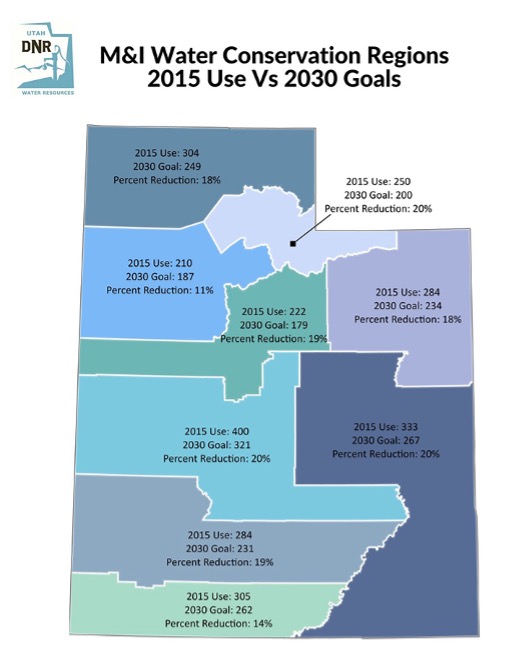Data Gathering
To help meet Utah’s projected water demands through 2065, the Utah Division of Water Resources (UDWRe) has divided the state into regions and developed conservation goals specific to each region. Conservation and water management requires planning, data collection and the cooperation from all water providers (wholesale and retail) to meet the regional water conservation goals.

The data collection part of developing a conservation and water use management plan is vital for the outcomes to be achieved in the proper time frame and in the most reasonable and efficient way. The Conservation Plan will likely include information that answers the following questions:
- How much will it cost to achieve the UDWRe conservation goals or other levels of conservation?
- Is there another level of conservation that may provide a greater benefit to a system’s service area and broader river basin or region?
- How much can be saved through each conservation measure, and when can those savings be expected?
- Who will likely pay for implementation of the selected conservation measures?
- How will the water provider/City/entity know if their plan is being effective?
Data collection can come from previous water records, State water use data, customer surveys and inputs from various areas within the water system that may have differing demands. For example, commercial areas will have different demands than residential areas. Institutional water users will have different water use patterns compared to residential or commercial. Gathering data to establish existing use trends and existing supplies is necessary for the planning effort to be successful. As more data is collected with improved methodology, water use data reliability will likely improve.
Set Conservation Goals
Based on the data collected and analyzed using the best methodology available, conservation goals can be set that will provide the direction and time frame to meet the needs of the agency in specific time frames going forward. Goals will consider potential variabilities in climate from year to year, growth projections, and proposed programs that outline the desired benchmarks for reductions or per capita use values that are desired.
Goals will also be set based on the level of investment in financing and in staff time in order to meet desired outcomes. Some areas may need aggressive conservation goals due to lack of additional supply, where other areas may have less aggressive goals due to slower growth, more water resource availability, or potentially other factors. Many smaller providers or smaller municipal systems can work with the local regional providers and the state on programs that are already available. This may require less administrative work or staff, but may require the implementation of policy, code, or ordinances to qualify for the programs offered regionally or statewide that may help achieve the desired levels of conservation within that area.
Goals should have timeframes and measurable outcomes to be effective. Some goals based on available data may be for future outcomes and based on data collected in the short term.
How to Pick the Right Initiative for Your Community
Picking the right programs or initiatives is important to achieve the desired results with the resources available. From the data collected, a list of initiatives should be developed from the highest priority and yield to the least priority and yield. Looking at growth rates in various areas that include residential, commercial, and institutional users will also help in the selection of the correct initiatives that may be needed. Programs and initiatives could include but are not limited to the following:
- Residential or Commercial Smart irrigation controller rebates
- Flow sensor rebates
- Pressure compensating spray head rebates
- Landscape modifications (turf removal, flip your strip, Localscapes) rebates
- Low flow toilet rebates
- Low flow shower head rebates
- Car wash efficiency incentives
- School building retrofits
- Older apartment complex retrofits or rebates
- Hotel or motel retrofits or incentive programs
- Training and education for landscape professionals,
- Public education programs involving schools, churches, and other institutions
- Providing water audits
- Targeted use of AMI data for specific customer classes
Selection of the proper programs or initiatives should be based on current data with the knowledge that programs will evolve and change over time as savings are achieved. The combination of incentives and good policy are important to achieve goals and manage water to the maximum extent possible.
How to Get the Word Out
Getting support from the community or from the customer base in the area is critical to achieving goals and providing an adequate water supply in the future. Education provides the backbone for any conservation programming or initiative. Public awareness and knowledge of how users can implement the desired goals or programs can drive widespread action with the least amount of effort or administrative load. While the effectiveness of education programs may be difficult to measure or quantify, education increases the awareness of the issues and programs, and produces more effective program outcomes.
Education can take many forms and use different media to educate the public properly. It is important that programs are promoted in a way that users know why the program exists, why it is important to them and how their participation will make a difference. The incentives that go with programs will help to provide momentum and increase participation, but continued education will let users know that their contribution is noticed, appreciated, and is making a difference. Use existing or new partnerships, existing communication paths, media buys, print, digital, and any other means to get information to the end users.
